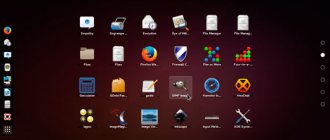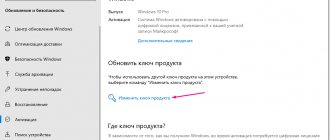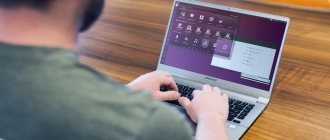Nowadays, dual power has established in the market of mobile operating systems. The audience of users was divided between iOS and Android, displacing almost all competitors.
Not every gadget lover can immediately name a couple of current operating systems for smartphones. Those who did not use smart phones at all 7-10 years ago did not see the era of formation and development of this niche.
We invite you to remember the birth of smartphones and the evolution of mobile operating systems. Almost all of the projects that existed at that time have already been closed, but they made a significant contribution to the development of the mobile electronics segment that is popular today.
Symbian OS. A dinosaur of the mobile OS market that was quickly forgotten
1998-2012
Interface of early versions of Symbian
In 1998, Nokia contributed to the formation of the Symbian concern, which began developing a new operating system of the same name. Even then, the Finnish phone manufacturer caught the trends in market development and saw the future in expanding the capabilities of regular dialers.
Already at the end of 1999, the first version of the EPOC Release 5 operating system was released, which was later renamed Symbian OS v5. Nokia's initiatives were supported by other phone manufacturers Samsung, Motorola, and Sony Ericsson. Later, many interesting smartphone models based on Symbian OS were released under these brands.
At the beginning of the 2000s, Symbian confidently occupied a leading position in the smart phone market and became the main mobile OS for almost the entire next decade. A huge number of applications and games have been written for this OS. Of course, this cannot be compared with modern indicators of Android and iOS, but developers simply did not have such convenient platforms for selling and promoting their programs.
Symbian first introduced the mass consumer to multitasking in phones, then an office suite, utilities for working with files and other analogues of PC applications appeared on the tiny screens of push-button dialers.
Nokia 5800 was not the most successful and was late in entering the market.
The developers were in no hurry to adapt their system for touch control, and Nokia was dragging its feet on mass models of touch smartphones. As a result, Nokia 5800 was introduced only in 2008. It was the first touchscreen smartphone on the S60 platform. Even then it became clear that the collapse of Symbian was inevitable. The company spent too long in the niche of button-controlled devices and slept through the popularity of touch screens.
The experience of using the very first version of iPhone OS was many times more pleasant than using Symbian, which has been developing for almost 10 years. The user could handle the iPhone just fine using his fingers, while Nokia models came with a thin, awkward plastic stylus.
The first Apple smartphone and the nth Nokia smartphone. The difference in user interface convenience is colossal
The peak of Symbian development occurred in 2005-2008. At this time, the system single-handedly reigned in the niche of smart phones and occupied from 55% to 73% of the market (in the record year of 2006). Later, Symbian’s share began to gradually decline, iOS began to catch on its heels, Windows Phone was actively sold for a couple of years, and then Android rapidly took off.
So in 2010, every third smartphone buyer still preferred Symbian; by the end of the year, Android OS could already boast similar indicators. Over the next two years, the share of the “green robot” doubled, but Symbian lost ground and by the end of 2012 was installed on approximately 6-7% of smartphones sold.
Nokia E7 communicator running Symbian
The decline of this operating system coincided with big problems for Nokia. At the end of 2012, the latest version of Symbian was released, and a little more than a year later, the Finnish brand was already being purchased by Microsoft.
iOS
iOS is developed by Apple and is installed only on iPhone and iPad.
As of 2019, it ranks second in terms of market presence. The current version is iOS 12, but installation of iOS 13 will begin on September 19, 2022. Among the most anticipated innovations are the “dark” mode and the QuickPath function (by sliding your finger across the keyboard you can type a word). iOS features are:
- Security - the system functions in such a way that a virus attack is completely excluded.
- Rich store. There are just over 1 million applications in the AppStore - iOS is quantitatively inferior to Android in this regard, but you need to remember that the OS is closed source, therefore, all applications are written only by professional programmers and are of high quality.
- The iPhone owner's virtual assistant, Siri, is capable of executing commands and even conducting a dialogue with a person.
- It is believed that the iOS interface is more user-friendly and requires minimal time to master.
iOS is also not without its shortcomings. For example, the user will have to download a song to the device’s memory through a special iTunes program. Difficulties in data transfer are a kind of payment for increased security. There is only one application store - and most of the software offered is distributed on a paid basis.
Windows Mobile. Operating system for business and geeks
2000-2010
This system was developed by Microsoft for installation in PDA (Pocket PC) models. The system was released in 2000; during its creation, the mobile OS changed several names and code names; it was also called Windows CE or Windows Pocket PC Edition.
The interface was based on the guidelines of the Windows desktop operating system, and some interface elements were also migrated from there. The key feature of Windows Mobile was a set of pre-installed software from Microsoft, which included the main utilities from the office suite and the Internet Explorer browser. Of course, the applications had limited functionality, as evidenced by the “Pocket” mark in the name of each program.
The system recognized handwritten text well, which had to be written with a special stylus. Users were attracted by the functional email client and access to the file system, similar to data management on a PC.
The developers did not set out to make the system easy to use or easy to learn. The programmers tried to transfer the experience of using a full-fledged computer to a small pocket gadget as much as possible. So, accustomed to all the features and problems of desktop Windows, users of PDAs running Windows Mobile felt right at home. The desktop had familiar elements like the Start button and the taskbar.
Later, the development of the system was divided into two global branches: for PDAs (Windows Mobile Professional and Windows Mobile Classic) and for smartphones (Windows Mobile Standard).
In the first case, the system developed in the initially specified direction and was aimed at large “handhelds” for its time with the obligatory use of a stylus. This is due to the large number of small elements and not the most convenient on-screen keyboard for entering text.
In the second case, the system was seriously redesigned for control from push-button smartphones. Navigation through menu items could only be done using keys; the touch display was not a required element for operation. The on-screen keyboard was supposed to be replaced by the QWERT buttons of the mobile device.
Although the core of the operating systems was the same, the libraries and modules used were different, which often made it impossible to run applications for the Professional version on the Standard version and vice versa.
At first, Windows Mobile felt confident in the business segment, but the situation began to change in the late 2000s. The Palm OS operating system won a significant market share, some users became interested in BlackBerry smartphones running the system of the same name, and iOS (iPhone OS) and Android began their development in 2007 and 2008, respectively. Thus, one of the most popular operating systems in business of the era of smartphone development first fell out of the top three, then out of the top five, and already 10 years after its launch it occupied a modest 4-5% of the business niche.
At the beginning of 2010, Microsoft announced the successor to Windows Mobile - the new Windows Phone mobile system, and a few months later stopped releasing updates to the old system.
Synchronization with computer and file transfer
Connecting to a computer and synchronization are entering the ring of the Android vs iOS war. What do you need to transfer music, movies or clips from your hard drive to your Android smartphone? Yes, almost nothing - we connect the device to the computer, select the desired folder and upload the necessary files into it . That is, Android devices are defined as ordinary removable media.
You won't be able to transfer files to iOS devices using a regular file manager - they are not perceived by computers as removable drives. To download files, you must use a special iTunes application. It is also used to download purchased videos and music from the Apple branded multimedia store. That is, we cannot come to visit someone, connect a smartphone to a computer and download the content we like - we must use iTunes (which may not be on someone else’s computer).
But with the help of iTunes it is convenient to create backup copies and update software in gadgets. In the case of Android devices, you should use proprietary applications from developers or look for universal software. But owners of Android devices do not need any programs to simply upload files.
iTunes is very convenient for synchronizing data, purchasing content, and working with applications. But the inability to use iOS devices as removable storage somewhat overshadows the charms of iTunes.
Windows Phone. Tiled design and minimum third-party applications
2010-2015
To replace the mobile operating system that had lost popularity, Microsoft introduced a new one, written from scratch, Windows Phone. Although the system was a successor to the Mobile version, they were completely incompatible.
The company relied on a new tiled interface and integration with its own services Xbox Live and Zune. The system itself acted in a broader consumer niche without any pretensions to the corporate segment. Users accustomed to Windows Mobile were forced to change not only their favorite gadgets, but also choose a different operating system for work.
Development of the new OS has been going on since 2004, and the release was initially scheduled for 2009.
Tiled Metro interface for Windows Phone home screen
The main element of the system was the Metro interface with “live” interactive tiles. Square and rectangular menu items could display different information or simply serve as large shortcuts to launch installed applications.
The new OS became quite popular, it had most of the controls and applications familiar today.
Over the next few years, smartphones from Acer, Dell, Fujitsu, Highscreen, HTC, LG, Microsoft, Nokia, Samsung, Toshiba, ZTE and others were released on this platform.
Initially, users enthusiastically received the new mobile OS from Microsoft, but then Windows Phone smartphones began to sell worse and worse. At the peak of its popularity in 2013, only 5% of smartphones sold ran on Windows Phone; in the following years, the figure dropped significantly.
The convenience and performance of the system could not compete with the already fairly large players iOS and Android. Many consider the main disadvantage of Windows Phone to be poor integration with Microsoft's desktop OS, the lack of exclusive features in the ecosystem, and a slowly developing application store.
Cyanogen OS
Cyanogen OS was created as an alternative to Android. Initially, this OS was released as a mod for the same Android and it was called CyanogenMod.
It was intended for those who wanted to customize the operating system as much as possible “for themselves.” But then the developers decided to create a full-fledged OS. This is how Cyanogen OS was born.
The main feature is that there really are many times more customization options. This applies to the interface, all elements, screens, and so on.
Yes, at first glance, Cyanogen OS is no different from standard Android. But try to open the settings or even just swipe up and you will see how many unique features there are.
This way the user can quickly turn off the search bar, adjust wallpaper scrolling, grid size, enable animation, and so on. And this is just the tip of the iceberg!
Rice. No. 5. Settings in Cyanogen OS
Therefore, if you are tired of Android and want to be able to customize everything you can, install Cyanogen OS. This is a very unusual and, it must be said, successful project!
BlackBerry OS. The king of the corporate segment that has not stood the test of time
1999-2013
This operating system was produced by Research In Motion Limited (RIM) for smartphones and communicators of its own production.
The operating system had an excellent implementation of multitasking and supported all kinds of input devices. Thus, during the existence of the BlackBerry brand, smartphones appeared with a regular keyboard, QWERTY keys, trackpad, trackball, scroll wheel and touch display.
The developers did not limit themselves to adding a new means of entering information, but closely woven it into the system. Convenient gestures, shortcuts and keyboard shortcuts were created. Interaction methods penetrated all corners of the system, standard and some third-party applications.
Initially, BlackBerry OS proved itself well in the corporate segment thanks to reliable encryption algorithms for mail, messages and other data migrating between users. Later, ordinary users also appreciated the advantages of the operating system and the BlackBerry gadgets themselves.
BlackBerry OS was doing quite well in the market. The system's popularity peaked in 2008-2009. At that time, about 20% of smartphones sold ran on this operating system. Until 2010, BlackBerry OS successfully competed with iOS and bypassed Apple's mobile system in terms of prevalence.
Already in the next 2011, the number of iPhones sold increases sharply, and Android completely captures half of the mobile market. BlackBerry OS is starting to lose ground in sync with Symbian. The percentage of gadgets with systems on the market first decreases to 10%, and already at the beginning of 2012 drops to 5%.
The thing is that BlackBerry management made two erroneous assumptions. At first, the company was skeptical about smartphones with touch displays; they were considered gadgets solely for entertainment, but not for business users. And then they believed that users were overly attached to their brand and did not consider the iPhone and Android smartphones to be worthy competitors.
When smartphone sales began to decline sharply, the company began to fuss and use all possible methods to save the brand. This is how BlackBerry models with a touch screen appeared, social network clients were actively built into gadgets, and an application store for third-party developers appeared. At this point, it became clear that the resources of the current generation of smartphones and the capabilities of the operating system were not enough to implement all the modern features.
To remedy the situation, an alternative system was quickly developed QNX , on the basis of which the company released several smartphones and a tablet. Application developers almost unanimously refused to create third-party programs for QNX for the sake of a rather modest user audience.
The fatal decision was the transfer of the company's latest smartphones to the Android . BlackBerry instantly lost its individuality, and the main advantage of the brand in the form of user data security was almost impossible to implement on Android.
So, along with the collapse of the company, the mobile operating system also ended its existence.
Blackberry
Blackberry OS is a QNX-based operating system for Blackberry devices, first released in 2009. At its core, it is aimed at the business segment, corporate users.
Mobile OS - advantages of Blackberry OS:
- technology that makes it possible to conduct business more efficiently, quickly manage your own business and rationally use human resources
- the ability to work remotely, outside the office, the ability to receive a contract, presentation, report on time, transfer important documents to work, without delaying a minute.
- constant synchronization with the workplace
- high security of corporate communications. Even if the device is lost or crashed, you will not lose your correspondence, your contacts; correspondence and other information can be remotely deleted from the lost device.
- allows you to quickly view large attachments of almost any format on the device
| “+” | “-” |
|
|
There are also a number of other operating systems, such as Symbian OS, BADA (Samsung) and others. But they are not as popular as the above.
Palm OS. At one time, this system beat Apple
1996-2007
Interface of the first versions of Palm OS
This is one of the early mobile operating systems for communicators, which actually brought mass consumers to the smart phone market in the second half of the 90s. The developers focused on a simple and understandable graphical interface. The Palm-powered gadget was easier to figure out than some desktop computers.
The system supported handwriting text input using a stylus, had a good standard set of applications, synchronized data with a PC, and supported many expansion modules for communicators.
It’s curious that it was Palm that practically buried Apple’s not-so-successful line of MessagePad smartphones.
The main drawback of the system, which appeared over time, was single-tasking. In the background, only the music player was running among all the applications, which made full multitasking impossible.
Even in this form, users really loved this OS for its simplicity and convenience (Jobs had not yet introduced iOS at that time).
However, at a certain point, the Palm company, which was engaged in both the development of the operating system and the release of communicators of the same name, was absorbed by Hewlett-Packard. Some of the staff were transferred to other projects, some left the company, and some were laid off.
As a result, the popular OS simply stopped receiving updates, and the once famous line of gadgets was quickly forgotten amid the advent of the iPhone and Android smartphones.
Paranoid Android
Paranoid Android is one of the most popular custom ROMs of all time. The development team focuses on delivering excellence with minimal resources.
Although it doesn't boast a lot of features and customizations that other ROMs offer, Paranoid Android or PA promises a smooth user experience .
It comes with its own unique features, such as a hover mode that allows the user to view and interact with their notifications from any screen (which was then integrated into AOSP as part of Heads-up notifications).
It also offers its own version of the PIE menu, as well as a fully immersive mode for Android. Paranoid Android has long been considered a major project where Google has implemented many features, one of the biggest features being Ambient Mode which was introduced in PA as Peek.
The recent PA update brings features like gesture controls, app lock , Pixel-style launcher, and more.
Pros:
- Based on Android AOSP
- Supports existing devices
- Stable and usable
Minuses:
- Depends on Google Play Services apps
- Not as customizable as some other Android ROMs
Visit the website
MaemoOS. They wanted to build an analogue of the iPad in Nokia on it
2010-2015
In the mid-2000s, one of Nokia’s divisions still felt global changes in the mobile gadgets market. A small department of specialists began developing a new niche of gadgets for that time - Internet tablets. The devices were larger than current smartphone models and were aimed at surfing the web, browsing, email, or watching videos.
It is curious that for the new line of gadgets they decided to use not the popular Symbian, but the new development of Maemo. This system was based on the Debian Linux kernel and was a freely distributed operating system.
Maemo OS was criticized for a large number of closed modules and the lack of source code for many standard applications. The developers did not listen to the wishes of users and developed the system solely in their own interests.
Communicator Nokia N810
Over the five years of existence of this OS, only four devices were released under its control: Nokia 770, Nokia N800, Nokia N810 and Nokia N900. Large companies and enthusiasts managed to release a sufficient number of applications for Maemo, but the project was abandoned.
Lots of possibilities in a small gadget
Today, such a device will not surprise anyone at all. After all, regular mobile devices have been replaced by smartphones – smart phones. Using such a device you can not only make calls or write SMS messages. These gadgets provide a lot of amazing features. You can listen to music, watch videos and even entire films, go online, visit social networks, use a navigator, alarm clock, calculator, flashlight and many other useful and interesting things. In the world of modern technology, almost every person has a smartphone. Most often, the capabilities of the device depend on the model or manufacturer. But the operating system plays a much larger role for the user. Operating systems for smartphones allow us to unleash the full potential of the gadget. The quality of its use depends on them. In this article we will talk about what is the best operating system for a smartphone and understand their main versions.
Bad OS. This is how Samsung wanted to make its own analogue of Android
2010-2012
Samsung has never “kept its eggs in one basket.” During the active development of mobile operating systems, the South Korean electronics manufacturer produced smartphones on almost every one of them. At some point, Samsung executives decided to release their own mobile OS.
This way, it would be possible to better optimize the software for your own hardware and not depend on third-party creators of operating systems, which very often cease to exist. A typical Samsung user in those days first used a push-button dialer, then became friends and exchanged information on Symbian with Nokia fans, later studied Windows Phone and was preparing to move to Android.
The Bada operating system was supposed to put an end to such throwing. At first, the OS suffered from typical illnesses of the launch versions.
Smartphone Samsung Wave II
So for some time, applications using VoIP could not work over Wi-Fi. Then third-party developers could not get the API to use all the smartphone's sensors. Some programs could not interact with the mailbox, receive or send messages. Although the system supported multitasking, it only worked with standard applications. Third-party programs were knocking each other out of the background.
All this pushed application and game developers away from the new platform, while there were no such problems on iOS and Android.
In the last year of the operating system's official existence, the number of smartphones sold running it exceeded the number of Windows Phone devices sold. And then both mobile operating systems disappeared into oblivion.
In total, during the system's support, 10 smartphones were released in the Samsung Wave line. Samsung managers increasingly gravitated towards the increasingly popular Android, and for experiments they switched to the more self-sufficient Tizen project.
LineageOS
LineageOS is the same custom ROM that was launched as CyanogenMod. Back in the fall of 2016, Cyanogen Inc. announced that it was ceasing development and shutting down the infrastructure behind the project.
Since then, the developer community has supported the project, but under the name LineageOS. Built on top of Google's AOSP code and adding its own code to it, LineageOS runs as a standalone ROM.
It has the largest development team under its name and officially supports over 190 devices. The ROM contains basic yet useful features that include but are not limited to customizing the status bar, changing the overall theme, editing the navigation bar, and more.
While Google's AOSP is raw, LineageOS gives a feeling of customization while maintaining stability. The ROM offers a build for Android Marshmallow (6.x) and Nougat (7.x), with support for Oreo (8.0) coming soon. The list of officially supported devices also includes offers from Samsung, HTC, Motorola, LG, Xiaomi, OnePlus and others.
Pros:
- Based on Android AOSP
- Supports existing devices
- Stable and usable
Minuses:
- Depends on Google Play Services apps
Visit the website
MeeGo OS. It was supposed to be the most versatile mobile OS
2010-2012
Interface of earlier versions of MeeGo OS
Enthusiasts and geeks really liked the idea of Maemo, which was based on the Linux kernel. After the closure of the Nokia project, an independent group of developers was formed, which created a more advanced clone of Maemo, taking into account the suggestions and wishes of ordinary users.
The main idea of MeeGo was system scalability and a large number of potentially supported devices. Thus, there were special builds of the mobile OS for smartphones and tablets, a more powerful and functional system for netbooks, and special lightweight versions for smart TVs and set-top boxes.
The first official version of MeeGo was demonstrated to the public at the MWC conference in early 2010. Many large companies became interested in the idea; divisions of Nokia, Samsung, Intel, Pioneer, and Cisco joined the development group. By the end of the year, the community formed around the system managed to receive large investments from automobile manufacturers BMW, GM, Peugeot, Citroën, Renault and Hyundai.
Nokia N9 smartphone
Initially everything looked very promising. The first versions of the system demonstrated good performance on average hardware, worked stably, and the user received good multitasking and a large number of convenient control gestures, which were not available in the “young” iOS and Android at that time.
Unfortunately, such a large-scale ambitious project awaited collapse and oblivion. The decision of the board of directors of Nokia, which at that time was going through hard times, is to blame. The company tried in every possible way to stay in the smartphone market, and managers saw salvation not in the new MeeGo OS, but in Windows Phone from Microsoft. The promising development was abandoned, and the rest of the companies that invested in the idea simply did not have the opportunity to develop and improve the system.
Thus, only three smartphones were released under MeeGo: Nokia N9, Nokia N900 and Nokia N950. In 2012, development of the operating system ceased.
Symbian
Nokia remains the official owner of OS Symbian. All manufacturers who in one way or another use this system in their developments must agree with the owner on permission to use it. The company dominates the segment of low-cost budget devices that use Java Symbian. However, there has been a downward trend in demand for this product.
Such an OS is very convenient and well designed, but recent developments from other manufacturers are reducing its demand on the market.
Sailfish OS. It exists and is still developing
2013 is our time
Finnish developers from Nokia, who were involved in the creation of MeeGo, left the company after the project was suspended. Also in 2012, they founded their startup Jolla , which began creating the Sailfish OS operating system.
Thus, this project was based on developments from the previous systems Maemo and MeeGo. Most of Sailfish was open source, but some elements were closed to third-party developers. This is how the creators of Sailfish wanted to monetize their own project. They offered the basic operating system for free, but provided advanced features through a licensing agreement with the electronics manufacturer.
The most promising of these extensions was the Alien Dalvik module, which made it possible to install Android applications into the operating system.
Sony Xperia X smartphone
Since 2013, developers have steadily released key updates for Sailfish. In the same year, the first smartphone running this OS, Estrade, was released. Over the following years, several more devices with Sailfish OS on board were released. The most popular of them were Sony Xperia X and Sony Xperia XA2.
In 2022, 70% of the rights to the operating system were acquired by the domestic Rostelecom. The official offshoot of Sailfish was the Russian development of Aurora OS, which in the coming years should become a unified operating system for mobile devices of employees of government agencies and budgetary organizations.
The Sailfish project slowly but surely continues its development today.
BADA
The efficiency and convenience of this product are comparable to Android OS. A giant like Samsung has the rights to use it. It is difficult to explain what the leaders of the concern are guided by without using BADA on the same industrial scale as other systems. It is almost impossible to find flaws in the design, and with minimal promotion its popularity among consumers could be guaranteed. To date, the application is provided only in the design of three Samsung models.
TizenOS. The system smoothly moved from smartphones and tablets to watches and TVs
2013 is our time
This system is also rightfully considered a successor to the ideas of Maemo and MeeGo. If the Finnish MeeGo developers from Nokia began developing Sailfish, then unemployed former employees from Intel and Samsung worked on the creation of Tizen.
Tizen did not focus exclusively on smartphones and continued the main idea of MeeGo - multiplatform. In a couple of years, the creators of Tizen were able to make working OS builds for smartphones, smartwatches, tablets, netbooks and even digital cameras.
The development did not go unnoticed; Samsung became interested in it and even released several Tizen smartphones for different local markets. The system performed well, but could not compete with the “green robot” that had gained popularity.
The South Korean brand did not give up on Tizen, taking advantage of the main feature of the system. It was quickly adapted to smart watches and smart TVs. Until now, many models of Samsung TVs and watches run Tizen.
Ubuntu Touch. This was supposed to be a full-fledged Linux in a smartphone
2013-2017
This system was developed by Canonical Ltd and was designed to run on smartphones or tablets. As the name implies, the mobile OS is based on the popular Linux build Ubuntu. The Unity shell was developed specifically for this, which made it possible to control the system using a touch display and convenient gestures.
Although the core of the mobile and desktop operating systems is the same, desktop applications should have been modified to work on smartphones and tablets. Software updates in Ubuntu Touch came from separate repositories that contained only optimized applications.
In addition to the standard set of programs for Ubuntu Touch, Facebook, Telegram, and YouTube clients were released. There was a complete set of basic software for everyday work, both from the creators of the system and from third-party enthusiasts.
A key feature of the system was the ability to connect a smartphone or tablet to a large display and turn it into a full-fledged work computer. This feature was invented before Samsung showed off its DeX station. Even the ability to carry a full-fledged computer in your pocket did not attract a mass audience to Ubuntu Touch.
A total of four devices were released running this OS: BQ Aquaris, Meizu MX4, Meizu PRO 5 and the outlandish QWERTZ smartphone PRO F(x) tec. While the mobile version of the system worked stably on a smartphone, the developers were unable to implement the so-called desktop mode. Stated plans to create a full-fledged desktop system in a smartphone failed. When connecting gadgets to a large screen, they began to wildly glitch, crash and did not provide the required performance.
Customer interest turned out to be extremely low, and even the active community of Linux users greeted the mobile OS coolly. As a result, in 2022, project leaders announced the cessation of official development of Ubuntu Touch. Two years later, the UBports programming community continued to develop the project, and unofficial builds and updates are still being released to this day.
Disadvantages of "Robot"
Among the shortcomings of the operating system, we can only note that everyone has long been bored with it, and even despite the fact that updates and new versions of the system are regularly released, its interface itself and the “little green men” on the screen are quite annoying. Plus, users too often complain about lags and system errors. It is not perfect at all, although the developers made sure that updates were released quite often, and accordingly, errors and errors were corrected.
This system is also highly susceptible to attack by various viruses. To avoid this, you have to download additional antivirus programs. The cause of this problem is most often applications ordered from unverified sources, and even Google’s brainchild, Google Play, does not always thoroughly check its products. Now all that remains to be discussed is the advantages of the system.
FirefoxOS. When did you decide to make an OS out of a browser?
2013-2015
The Mozilla Foundation , which supports the Mozilla project and manages its development, decided in 2012 to create its own mobile operating system, taking into account existing developments and patents.
Already in 2013, the first working builds of the new OS were shown, and at the end of the year sales of the first smartphones with Firefox OS on board began. Mozilla's main partner was ZTE; in collaboration with it, several models of smartphones based on Firefox were released.
The developers used part of the Android code and added their own Web API to support the basic functions of the smartphone. The system was open; any developer could create applications for it. However, to reduce hardware requirements and ensure fast operation of the system, its creators decided to limit the range of supported languages for web-based applications.
So it was possible to write an application for Firefox only in HTML5, CSS or JavaScript. It is almost impossible to create a sufficiently complex program using JavaScript, let alone games. As a result, the operating system remained incomprehensible to the mass consumer.
The project was closed two years after its launch.
For Yablochka users
It is quite obvious that the system has not gained momentum in popularity due to the high cost of Apple products. This “OS” is not tormented by viruses thanks to its unique Linux-based program code. All Apple devices synchronize perfectly with each other, however, working with other operating systems on IOS is difficult. It is also very difficult to install the operating system yourself. You can even reflash an Android smartphone at home, but with Apple it’s almost impossible to do this.
All smartphone operating systems have their advantages and disadvantages, but the choice is always yours.











